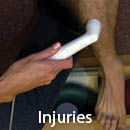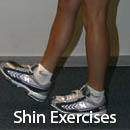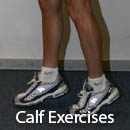Race Walking Training
Injuries, Treatments & Nutrition
OTHER PROBLEMS
Athlete’s Foot
Commonly known as “athlete’s foot,” this fungal infection of the foot usually begins with peeling skin and redness between the toes. Often associated with itching, athlete’s foot may involve the nails as well. While athlete’s foot is treated with over-the-counter powders, creams and solutions, it may reoccur. Keep your foot dry, throw your socks in the washing machine with bleach (an enemy of fungus) and use socks that wick moisture away from the feet.
Plantar Warts
Plantar warts are small thickened growths, usually occurring on the soles of the feet. Caused by a viral organism, they can be painful if located directly under the weight-bearing part of the foot. Treat them with over-the-counter solutions. Do not shave or cut them; this leads to spreading them on yourself and others. Follow the directions for treatment carefully and keep your feet dry.
Blisters
One of the most common problems faced by beginning race walkers, as well as more experienced ones, is the dreaded blister. Friction caused by improperly fitting walking shoes, particularly if one foot is larger than the other, is an obvious culprit, but it’s not the only one. Irregular walking terrain also leads to blisters.
Everyone’s question is to pop or not to pop the blister. Do not pop your blister! An open wound invites unwanted organisms. Depending on the size and location of a blister, usually a sterile covering protects it and prevents more friction. Soaking your foot in a salt solution may pull water out of the blister through osmosis.
If the blister is open, an antiseptic such as iodine or alcohol prevents infection. For recurring blisters, consider the source, which may involve a change in the way the foot contacts the ground in the shoe. Often, a change of shoe insoles makes a difference in the amount of friction the foot experiences.
Nail Problems
With constant pressure from improperly fitting shoes, blood vessels may break under the nail, causing blood to collect underneath. Leading to a condition called black toenail, this usually does not cause pain, but may lead to the loss of your toenail. If pain exists, soaking the foot in warm water may release the blood underneath the nail and alleviate the pain.
Thickening of the toenails is sometimes related to constant pressure, but occurs without the change in color. Fungus can enter into these nails, making them difficult to cut, and contributing to their loss and pain. Height as well as width of a shoe’s toebox usually causes these ailments. The shape of the toes or contracture of the joints also plays a significant role.


























